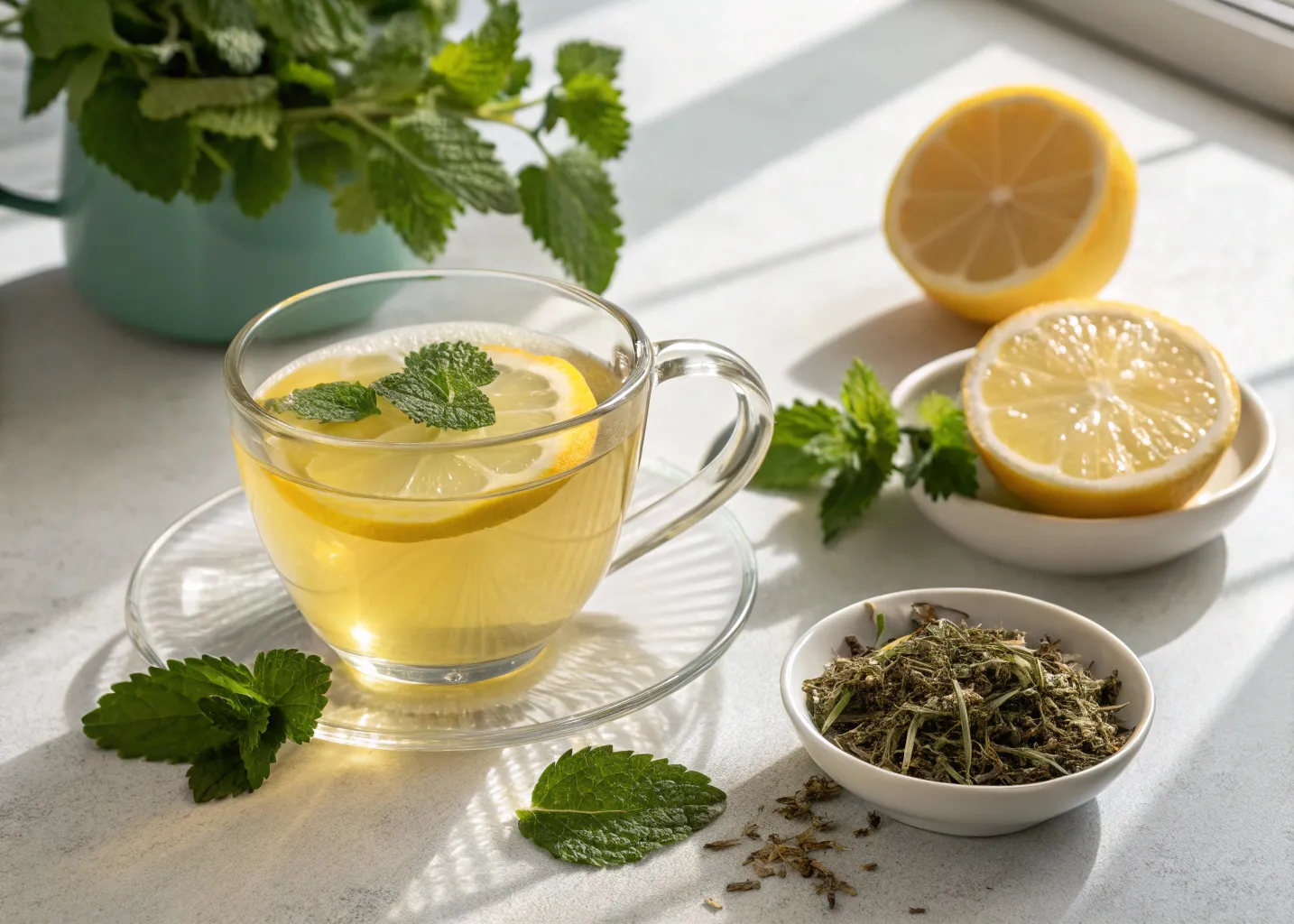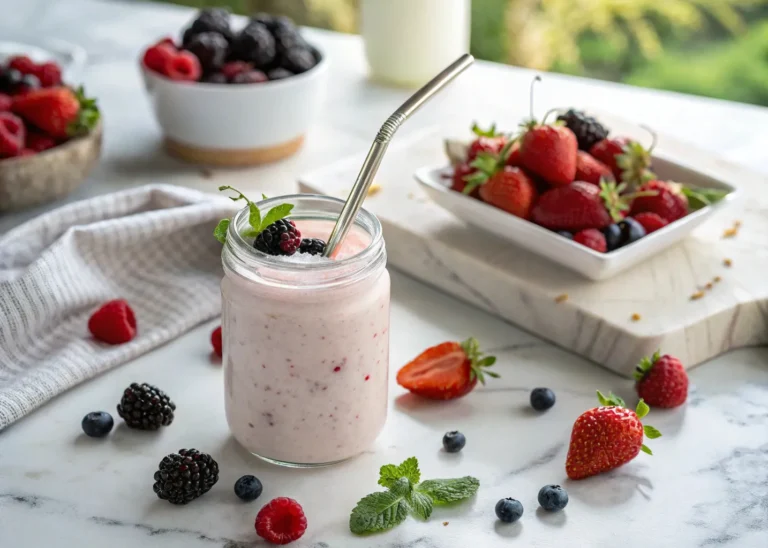Looking for a soothing, all-natural way to unwind? Lemon balm tea might just be your new favorite ritual. This ancient herbal infusion, made from the leaves of Melissa officinalis, delivers not only a refreshing lemony aroma but also a range of calming health benefits backed by herbalists and wellness experts alike.
In this guide, you’ll discover a simple, effective lemon balm tea recipe — plus the best methods for brewing it fresh, how much lemon balm to use, when to drink it, and who should avoid it. Whether you’re growing your own herbs or picking up dried lemon balm at the store, this step-by-step breakdown will help you prepare the perfect cup every time.
Let’s start brewing.
Understanding Lemon Balm and Its Benefits
What Is Lemon Balm and Why Is It Used in Tea?
Lemon balm (Melissa officinalis) is a perennial herb in the mint family, known for its gentle lemon scent and slightly sweet flavor. It’s been used in traditional medicine for centuries — from Ancient Greece to modern Europe — primarily to calm the nerves, ease indigestion, and support restful sleep.
Its mild, non-caffeinated nature makes it the perfect choice for a bedtime tea or an afternoon pick-me-up without the jitters. While many people enjoy it for its taste alone, the real value lies in its therapeutic properties.
Top Health Benefits of Lemon Balm Tea
Lemon balm tea isn’t just about comfort — it packs a punch when it comes to natural wellness. Here are the key evidence-based benefits:
| Health Benefit | How It Works |
|---|---|
| Relieves stress | Acts as a mild sedative on the nervous system, promoting calmness. |
| Improves sleep | Encourages deeper, more restful sleep when taken in the evening. |
| Eases digestion | Reduces bloating, gas, and nausea. |
| Supports cognitive function | May improve memory and focus under stress. |
| Fights cold sores | Contains antiviral compounds that may reduce herpes outbreaks. |
Several studies show that lemon balm can ease symptoms of anxiety and mild depression when consumed regularly. Its high content of rosmarinic acid and flavonoids are believed to be the source of its calming effects.
Nutritional Profile of Lemon Balm (Per Cup of Brewed Tea)
| Nutrient | Amount |
|---|---|
| Calories | 0 (unsweetened) |
| Caffeine | 0 mg |
| Vitamin C | Trace amounts |
| Antioxidants | High (Polyphenols, Flavonoids) |
| Active Compounds | Rosmarinic acid, Eugenol, Tannins |
Why People Prefer Lemon Balm Over Other Herbal Teas
Unlike stronger herbs like valerian or bitter ones like wormwood, lemon balm is pleasant, gentle, and well-tolerated by most people. It has a naturally uplifting aroma, and its taste pairs well with honey, mint, or lemon. It’s commonly used by:
- Individuals seeking natural anxiety relief
- People with sleep disturbances
- Herbalists creating blends for digestion support
- Those looking for a caffeine-free daily drink
Whether you’re looking to relax or simply enjoy a refreshing beverage, lemon balm tea is a go-to herbal infusion.
The Perfect Lemon Balm Tea Recipe
Step-by-Step Lemon Balm Tea Recipe for Maximum Flavor
Ready to make a cup of this calming herbal goodness? Follow this simple lemon balm tea recipe that works beautifully whether you’re using fresh or dried leaves.
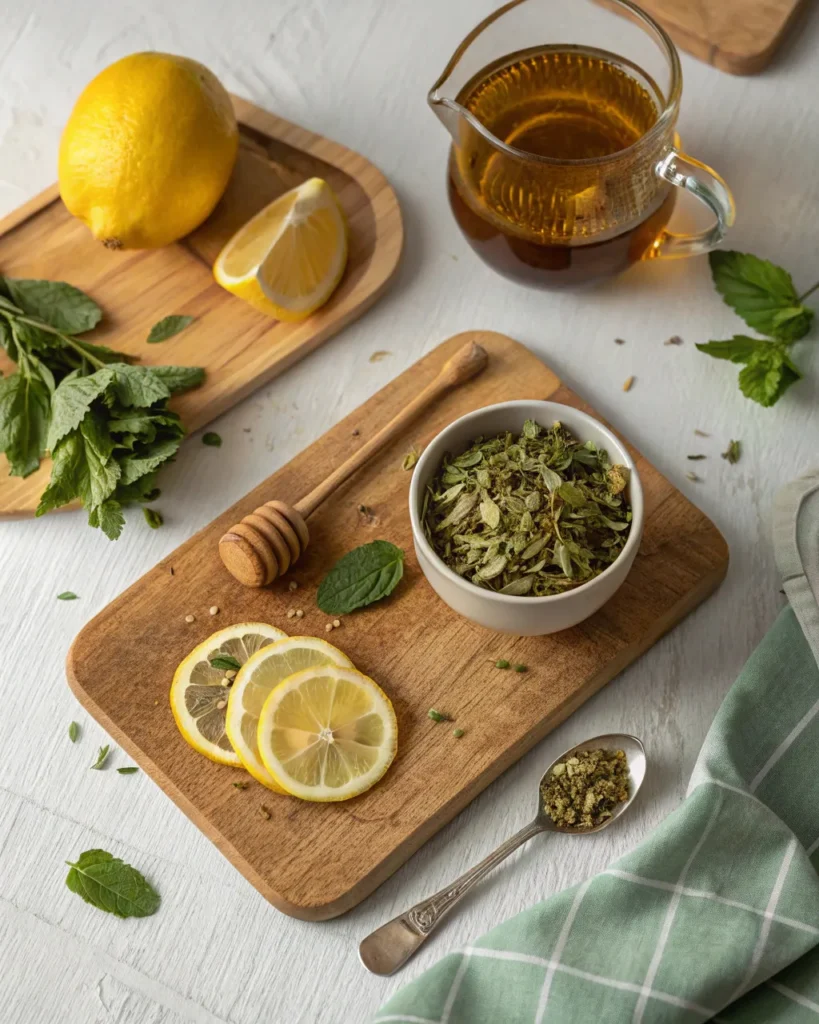
Ingredients:
- 1 tablespoon of fresh lemon balm leaves (or 1 teaspoon of dried lemon balm)
- 1 cup of freshly boiled filtered water
- Optional: honey, lemon slice, or fresh mint
Instructions:
- Prepare the leaves
Rinse fresh lemon balm leaves gently under cool water. Tear or crush them slightly to release the oils. If using dried lemon balm, measure it into a tea infuser or teapot. - Boil water
Heat 1 cup (8 oz) of filtered water until just boiling, around 200°F (93°C). - Steep the tea
Pour hot water over the lemon balm leaves. Cover the cup or teapot and let it steep for 7–10 minutes. The longer it steeps, the stronger the flavor and calming effects. - Strain and serve
Remove the leaves and pour the tea into your cup. Add a bit of honey or a slice of lemon if you like.
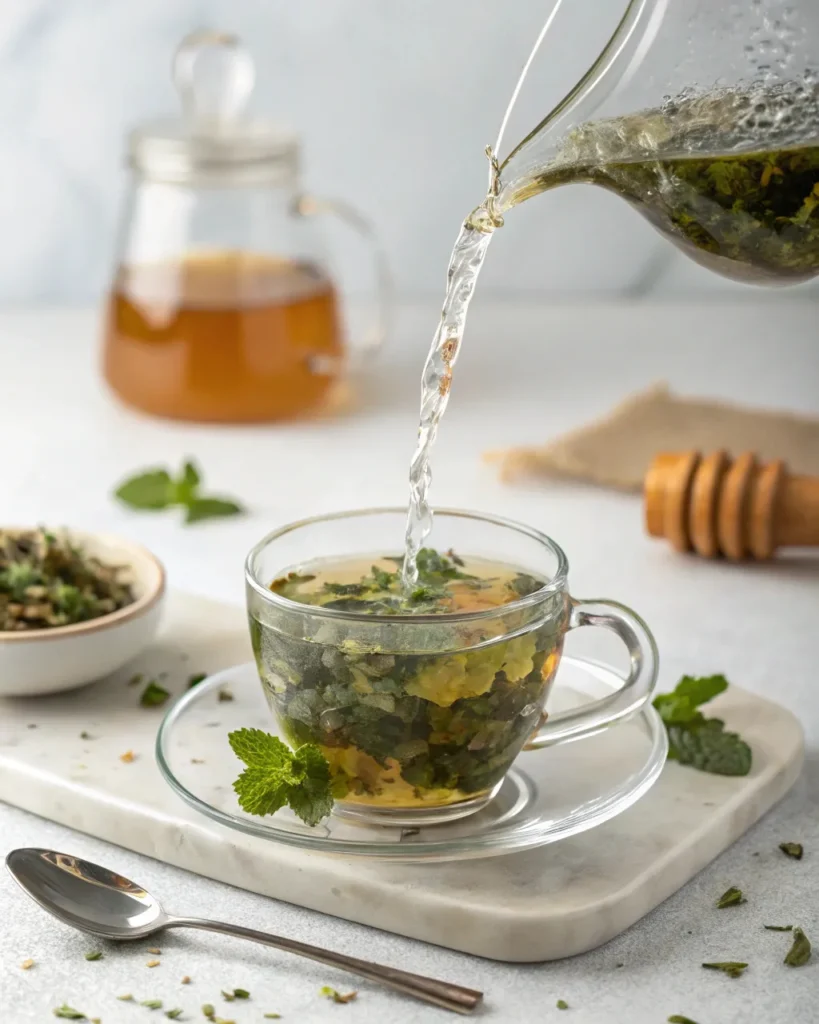
Looking for another refreshing herbal drink? Try this cucumber lemonade recipe — it’s light, bright, and perfect for hot days.
This recipe makes one serving. You can double or triple the amount for a teapot batch.
Tips for Enhancing the Flavor Naturally
Want to elevate your cup without ruining the natural profile of lemon balm? Try these gentle enhancers:
- Add lemon verbena or mint for brightness
- Infuse with chamomile for sleep support
- Use raw honey to sweeten naturally
- Top with lemon zest for added aroma
Avoid sugar-heavy syrups or milk, as they dull the herbal sharpness and reduce health benefits.
Pro Tip: For a stronger brew, let your lemon balm tea steep for 15 minutes and drink it warm in the evening.
How to Make Lemon Balm Tea Fresh from Your Garden
Harvesting and Preparing Fresh Lemon Balm Leaves
If you grow your own herbs, you’re in for a treat. Fresh lemon balm is more aromatic and flavorful than any store-bought version.
Here’s how to harvest and prep:
- Pick early in the day — right after morning dew dries. The oils are most potent then.
- Choose leaves before flowering for best taste and aroma.
- Use scissors to snip just above a node to encourage regrowth.
- Rinse gently and pat dry with a paper towel.
- Tear or bruise the leaves to release their natural oils before steeping.
Fresh lemon balm is fantastic for cold infusions too. Just place the leaves in cold water and refrigerate for 6–12 hours.
Using Fresh vs. Dried Lemon Balm: Which Is Better?
| Feature | Fresh Lemon Balm | Dried Lemon Balm |
|---|---|---|
| Flavor | Brighter, more citrusy | Earthy, slightly muted |
| Potency | Requires more leaves | More concentrated |
| Storage | Must be used quickly | Lasts for months in jars |
| Best For | Cold brews, immediate use | Year-round access |
Bottom Line:
- Use fresh lemon balm if you want a vibrant, garden-fresh experience.
- Go with dried lemon balm for convenience and stronger infusions.
If drying your own leaves, be sure to store them in an airtight glass jar away from sunlight. They’ll keep their flavor for about 6–9 months.
When and How to Drink Lemon Balm Tea for Maximum Benefits
Is It Better to Drink Lemon Balm Tea at Night or in the Morning?
Timing matters — especially with herbal teas like lemon balm that support the nervous system. So when’s the best time to enjoy this herbal brew?
Morning:
- A mild cup can ease digestive discomfort or bloating after breakfast.
- Helps manage daytime stress or anxious thoughts without making you drowsy.
Evening (Most Recommended):
- Drinking lemon balm tea about 30 minutes before bedtime can help calm your mind, reduce cortisol levels, and promote deeper sleep.
- Blending it with herbs like chamomile or lavender can enhance its sedative effects.
Verdict:
For stress relief during the day, drink it lightly steeped in the morning.
For relaxation and sleep, a stronger brew at night is ideal.
Ideal Dosage: How Much Lemon Balm Should You Use in Tea?
Getting the dosage right ensures maximum benefit without overdoing it.
| Form | Dosage (Per Cup) | Notes |
|---|---|---|
| Fresh Leaves | 1–2 tablespoons | Crush before use |
| Dried Leaves | 1–2 teaspoons | Packed with oils, use slightly less |
| Tea Bags | 1 bag per 8 oz water | Check label potency |
How often?
- 1–3 cups per day is generally safe for most adults.
- Start with one cup a day if you’re new to lemon balm.
Always steep the tea covered to retain its essential oils and medicinal compounds.
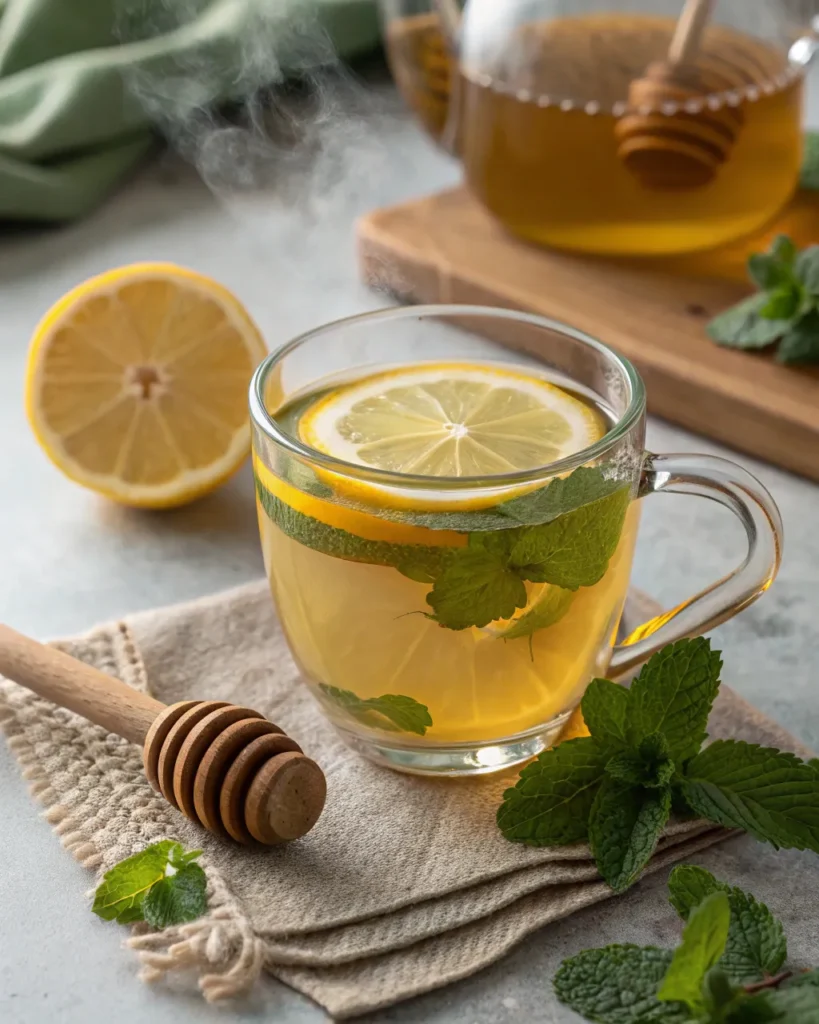
Who Should Not Drink Lemon Balm Tea?
Contraindications: Thyroid Issues, Pregnancy, and More
While lemon balm tea is considered safe for most people, there are a few key exceptions where caution — or complete avoidance — is necessary.
Avoid lemon balm tea if you:
- Have hypothyroidism or are on thyroid medication — lemon balm may interfere with thyroid hormone levels.
- Are pregnant or breastfeeding — there’s not enough safety data.
- Take sedative medications or muscle relaxants — it may intensify drowsiness.
- Have glaucoma — some research shows it may affect eye pressure.
- Are scheduled for surgery — discontinue use 2 weeks before due to sedative effects.
Always consult your healthcare provider before making herbal tea part of your daily wellness routine — especially if you’re managing a medical condition.
What Not to Mix with Lemon Balm Tea: Dangerous Interactions
Avoid combining lemon balm tea with the following unless supervised by a healthcare professional:
- Barbiturates or benzodiazepines (e.g., Xanax, Valium)
- Sleep medications (melatonin supplements, Z-drugs)
- Thyroid hormone treatments (e.g., levothyroxine)
- Alcohol – both act as CNS depressants and may intensify drowsiness
- Other strong sedative herbs – like valerian root or kava kava
Safe herbal pairings:
- Chamomile
- Passionflower
- Lavender
- Mint
These herbs are gentle and support similar benefits without the risks of over-sedation.
Can You Drink Lemon Balm Tea Every Day?
Is It Safe for Long-Term Use? Scientific Insights
Many people ask: Can I drink lemon balm tea every day? The short answer? Yes — for most people, it’s safe in moderation.
Scientific reviews suggest that lemon balm, especially in tea form, is well-tolerated for up to 6 months of daily use. Its mild nature and low concentration of active compounds (compared to extracts or capsules) make it suitable for regular consumption.
Caution: While occasional daily use is fine, it’s smart to take breaks after extended use (e.g., 1 week off every 6–8 weeks) to allow your body to reset — especially if you’re drinking 2–3 cups daily.
Daily Routine Integration: How Often Is Too Much?
For optimal results without overdoing it:
| Use Case | Recommended Frequency |
|---|---|
| General relaxation | 1 cup daily (evening or afternoon) |
| Sleep improvement | 1–2 cups before bed |
| Mild anxiety or digestion issues | Up to 3 cups daily, spaced out |
| Long-term use | Take a 1-week break every 6–8 weeks |
Don’t forget: Everyone’s body is different. If you experience any side effects like dizziness or low energy, reduce your intake and consult your doctor.
Different Ways to Brew Lemon Balm Tea
Cold Brew, Hot Infusion, and Lemon Balm Tea Blends
Tea isn’t a one-size-fits-all — and lemon balm tea offers plenty of room to experiment.
Here are three favorite brewing styles:
1. Hot Infusion (Traditional Method)
- Steep 1 tsp dried or 1 tbsp fresh lemon balm in boiling water for 7–10 minutes.
- Best for daily routines and before bedtime.
2. Cold Brew Lemon Balm Tea
- Add a handful of fresh lemon balm leaves to a jar of cold filtered water.
- Refrigerate for 6–12 hours, then strain and enjoy over ice.
- Ideal for summer, very refreshing and less bitter.
3. Lemon Balm Tea Blends
Try combining lemon balm with:
| Herb | Benefit |
|---|---|
| Chamomile | Extra relaxation, improved sleep |
| Peppermint | Eases digestion, freshens breath |
| Lavender | Reduces tension and anxiety |
| Ginger | Warms the body, helps nausea |
Pro Tip: Add a cinnamon stick or orange peel to hot blends in winter for a seasonal twist.
Pairing Lemon Balm with Other Herbs: Safe and Delicious Combos
Pairing safely is key. Here are some smart guidelines:
✅ Do Pair With:
- Chamomile
- Peppermint
- Spearmint
- Hibiscus
- Lavender
❌ Avoid Pairing With:
- Valerian root (too sedative)
- Kava (potential liver toxicity)
- St. John’s Wort (drug interactions)
- Any herb with known sedative-thyroid interaction
Storing Lemon Balm Tea and Leaves for Long-Term Use
Best Storage Practices for Dried and Fresh Lemon Balm
Proper storage can make or break your lemon balm tea experience. Whether you’re using fresh leaves from your garden or dried herbs from a supplier, keeping the flavor and potency intact is essential.
Storing Fresh Lemon Balm:
- Refrigerator: Wrap unwashed lemon balm leaves in a paper towel and place inside a perforated plastic bag. Store in the crisper drawer — lasts up to 5 days.
- Freezer: Rinse, pat dry, and freeze chopped leaves in ice cube trays with water. Great for tossing into teas or smoothies later.
Drying and Storing Dried Lemon Balm:
- Air-dry leaves in a shaded, well-ventilated space OR use a dehydrator at low temperature.
- Store dried leaves in an airtight glass jar away from light, moisture, and heat.
- Label with the drying date. Best used within 6–9 months for optimal potency.
Shelf Life and Spoilage Signs You Should Watch For
| Storage Type | Shelf Life | Warning Signs |
|---|---|---|
| Fresh (fridge) | 3–5 days | Yellowing, wilting, strong odor |
| Frozen | 4–6 months | Ice crystals, flavor loss |
| Dried (airtight) | 6–9 months | Mold, faded scent, discoloration |
Keep in mind, exposure to air, moisture, and sunlight rapidly degrades lemon balm’s volatile oils — meaning your tea will lose both flavor and therapeutic benefits.
Lemon Balm Tea for Kids and Special Groups
Can Children Drink Lemon Balm Tea Safely?
Lemon balm tea is considered generally safe for children over 3 years old, especially when used in small amounts to soothe tummy troubles or promote calm before bedtime.
Child Dosage Guidelines:
| Age | Dosage |
|---|---|
| 3–6 years | 1/4 cup of mild tea |
| 7–12 years | 1/2 to 3/4 cup |
| 13+ | 1 cup, like adults |
Always make the tea mild (shorter steep time) and consult a pediatrician if your child is on medication or has chronic conditions.
Special Populations: Elderly, Breastfeeding Moms, and Those on Medication
- Elderly: Lemon balm tea can gently support sleep and cognitive clarity. However, always consult a healthcare provider, especially if sedatives or heart medications are involved.
- Breastfeeding: There’s limited evidence. Avoid unless guided by a qualified herbalist.
- People on prescription meds: Especially those with thyroid issues, anxiety meds, or sedatives — interaction risks are real.
Frequently Asked Questions About Lemon Balm Tea
How do you make lemon balm tea?
To make lemon balm tea, steep 1 tablespoon of fresh leaves (or 1 teaspoon dried) in 1 cup of hot water for 7–10 minutes. Strain and enjoy. You can add honey or lemon for extra flavor. Covering the tea while it steeps helps preserve its calming essential oils.
What not to mix with lemon balm tea?
Avoid mixing lemon balm tea with:
- Sedative medications (like benzodiazepines or sleeping pills)
- Alcohol
- Thyroid hormone treatments
- Strong sedative herbs like valerian or kava
These combinations can cause excessive drowsiness or interfere with medical treatments.
Can I drink lemon balm tea every day?
Yes, most people can safely drink 1–2 cups of lemon balm tea daily. It’s gentle and well-tolerated. However, it’s best to take breaks after extended use and consult a healthcare provider if you’re on medication or have chronic health conditions.
How much lemon balm should I put in my tea?
For each cup, use:
- 1 tablespoon of fresh lemon balm leaves
- 1 teaspoon of dried lemon balm
Steep in hot water for 7–10 minutes. Increase steep time for a stronger effect, especially when used before bed.
Is it better to drink lemon balm tea at night or in the morning
Lemon balm tea is ideal in the evening, especially if you’re seeking sleep or stress relief. However, a light brew can also be helpful in the morning to gently reduce anxiety or digestive discomfort without causing drowsiness.
Who should not take lemon balm?
People who should avoid lemon balm include:
- Those with thyroid disorders (especially hypothyroidism)
- Pregnant or breastfeeding individuals (due to limited safety data)
- People taking sedatives or thyroid medication
- Anyone scheduled for surgery within 2 weeks (due to sedation risks)
Conclusion: Sip, Relax, and Enjoy the Gentle Power of Lemon Balm Tea
Whether you’re new to herbal teas or an experienced infuser, this lemon balm tea recipe brings together simplicity, flavor, and natural calm. From aiding digestion to helping you sleep better, lemon balm has stood the test of time as a trusted herbal ally.
Just remember to brew it fresh, store it properly, and use it mindfully — especially if you’re managing health conditions. Incorporate it into your daily or weekly wellness routine and enjoy the soothing benefits of this mint family marvel.
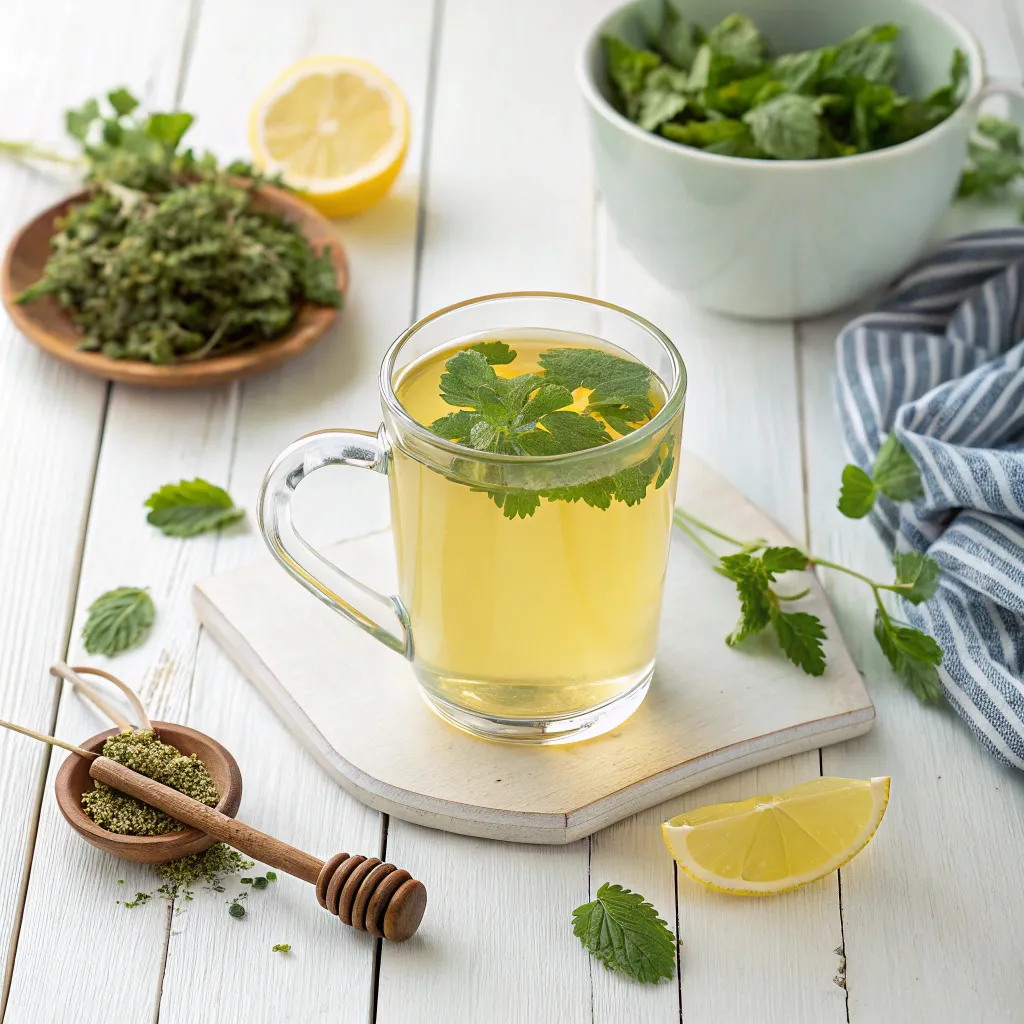
Lemon Balm Tea Recipe
Ingredients
Equipment
Method
- Rinse fresh lemon balm leaves (or measure dried leaves).
- Place them in a cup, strainer, or teapot.
- Boil water and let it cool slightly (200°F recommended).
- Pour water over the lemon balm.
- Cover and let it steep for 7–10 minutes.
- Strain leaves and pour tea into your cup.
- Add lemon or honey if desired, and enjoy.
Notes
- For a stronger brew, steep longer (up to 15 minutes).
- Use 1 teaspoon dried lemon balm if fresh leaves are not available.
- Best enjoyed 30 minutes before bedtime for sleep support.
- Safe to drink 1–3 times daily unless contraindicated (e.g. thyroid meds).


